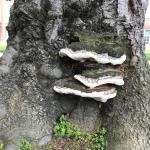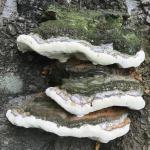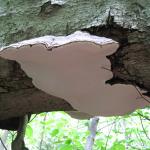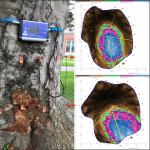Root and Trunk Rot caused by Ganoderma applanatum (Artist's Conk)
Pathogen
The native fungal pathogen Ganoderma applanatum is commonly known as the Artist’s Conk.
Hosts
Maple (Acer), beech (Fagus), and oak (Quercus) are primary hosts in southern New England (Luley 2022). However, G. applanatum has a broad host range among deciduous hardwoods, including birch (Betula), ash (Fraxinus), sycamore/ planetree (Platanus), aspen/ poplar/ cottonwood (Populus), willow (Salix), and basswood/ linden (Tilia) (Schwarze and Ferner 2003, Sinclair and Lyon 2005).
Symptoms & Signs
Ganoderma applanatum is a very common wood-decay pathogen in forests and managed landscapes. The fungus invades susceptible trees primarily through branch stubs and wounds on the lower trunk and is capable of decaying heartwood and sapwood (Sinclair and Lyon 2005). Serious decay in the trunk can develop over time and in certain cases, root decay can also occur. In the early stages of decay, infected wood undergoes a scattered, selective delignification. During this selective delignification, the wood retains stiffness and there is only a limited reduction in wood strength (Schwarze et al. 2000, Schwarze and Ferner 2003). Under controlled laboratory trials, it was found that G. applanatum was unable to colonize compartmentalized sapwood (Schwarze and Ferner 2003). This modified barrier zone, also known as the reaction zone or walls 1–3 in the CODIT model, has high concentrations of polyphenolic defense compounds. However, as the decay advances over time, lignin, cellulose and hemicellulose are broken down, resulting in a severe loss in wood strength (Luley 2022). Wood in an advanced stage of decay becomes bleached and spongy and is easily broken apart or peeled into strips.
The presence of conks often means extensive decay is present within infected trees. Silverborg (1954) noted that a single conk indicated a decay column spreading roughly 4–6’ above and below the fruiting body. Artist conks are shelf-like and fan-shaped, with a tannish brown to gray-colored upper surface (pileus) and brilliant white pore layer on the underside (hymenium). The upper surface is not waxy, but dull in appearance, and develops concentric “rings” as it grows annually. Conks typically survive for five to ten years (in some cases longer), reaching 8–12” in width and become rigid and woody with age. Because wood tissues are generally low in nutrients, the fungus must extract considerable resources to create even a single fruiting body. Spread is primarily through airborne dispersal of spores from the perennial conks. Ganoderma applanatum also acts as a saprophyte on stumps and downed logs and sometimes this mode overshadows its role as a serious decay pathogen.
Management
Under loading from strong winds, infected trees may suffer stem failure or uprooting without showing any prior symptoms of decay or canopy dieback. Trees with conks should receive a thorough risk assessment by an experienced arborist. Advanced testing methods, such as resistance drilling and sonic tomography, may be required to determine the severity of decay in the lower trunk. When conks occur higher up on the trunk, testing becomes more challenging. Tomography scans performed on trees in Massachusetts infected by G. applanatum often reveal extensive decay is present. In a note of caution, Schwarze and Ferner (2003) noted that G. applanatum readily grew from decaying wood through drill holes to colonize intact sapwood under controlled laboratory trials. Therefore, a breach of the compartmentalized zone within the trunk could help facilitate spread by the fungus into healthy tissue. Eradication of G. applanatum is not possible and fungicides are of little value against wood-decaying fungi because of their location within the heartwood. Avoid unnecessary wounding on trees that could serve as potential hosts for Ganoderma, especially when conks are actively disseminating spores. Physical trunk wounds, root flare wounds from lawn care equipment, and branch stubs can all serve as infection points in managed settings. As with any tree infected by a root and trunk rot pathogen, maintaining high tree vigor is important. If annual increment growth can keep pace with the rate of decay in the heartwood, especially during the early stages of infection, this may reduce the risk of failure. Maintain a large ring of mulch or wood chips around the tree and manage insect pests and pathogens that can weaken the tree. Improving soil quality may also increase vigor. Pruning to reduce canopy sway can also be performed. Regularly scout for the presence of conks and document their occurrence on the lower trunk.
Citations
Luley, CJ. 2022. Ganoderma applanatum. In: Wood Decay Fungi Common to the Northeast & Central United States, 2nd Edition. Urban Forest Diagnostics LLC, Naples, NY. Pp. 78–81.
Schwarze FWMR, Engels J, and Mattheck C. 2000. Fungal Strategies of Wood Decay in Trees. Springer, Berlin, Germany.
Schwarze FWMR and Ferner D. 2003. Ganoderma on trees — differentiation of species and studies of invasiveness. Arboricultural Journal 27(1): 59–77. doi.org/10.1080/03071375.2003.9747362
Silverborg, SB. 1954. Northern Hardwoods Cull Manual. State University of New York, Bulletin 31. 45 p.
Sinclair WA and Lyon HH. 2005. Diseases of Trees and Shrubs, 2nd edn. Cornell University Press, Ithaca, NY.





